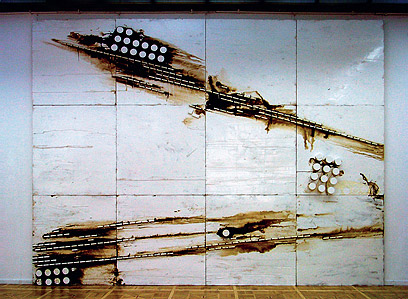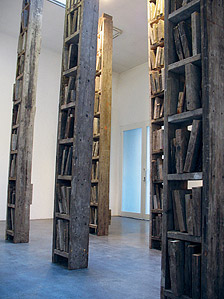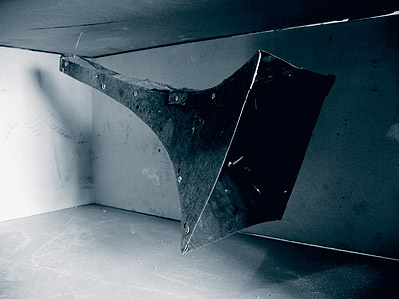 |
Peter Belyi
One of the deepest and subtlest of the St. Petersburg artists, Peter Bely concertedly explores the archaeology of cultural consciousness. For many years, he has been developing a project of "memorial modeling," in which he affirms culture as a current event outside of contemporaneity and contemporaneity as a future cultural layer for which trash is important.
The artist builds into our everyday reality a dimension of great responsibility - something akin to a fatedness to history. The artist's statement coincides with the materiality of the works, so that his installations do not have protagonists. Each of his works is a way of approaching fatedness in its broader sense, as an immaculate embodiment of history in thousands of private lives.
Alexander Evangely
|
 |
Born in 1971 in Leningrad USSR, Peter Belyi graduated in 1989 from the Secondary Art School of the Academy of Arts, and studied ceramics at Mukhin Academy of Applied Art from 1990 to 1992. He lived in London from 1995 to 2001 and graduated from Camberwell College in 2000 with an MA in Printmaking. He lives and works in St Petersburg, Russia mainly in printmaking, objects and installations. He teaches at the Smolnyi Institute in St Petersburg. He is a member of the Russian Union of Artists and the Royal Society of Painter-Printmakers.
|
|

Peter Belyi. White Project
2005.
Installation, mixed media, 300x600 cm
|
|

Peter Belyi. Pinocchio's Library
2008.
Installation, mixed media, dimensions vary
|
|

Peter Belyi. Minute of Silence
2008.
Installation, mixed media, 350x120x120 cm
|
|
|
|
Alexander Evangely: Have you ever tried to imagine art in fifty or a hundred years?
Peter Belyi: I've tried it. It's unpredictable. An artist is partly a social barometer, and the society of the future will demand from him that which he should be producing - a certain aesthetic. Right now, everything is overloaded with aesthetics, the streets are an endless stream of visuality, and in the future world, galleries, it would seem, will become that sort of space where you can simply not see anything, have a rest. There won't be anything there, only empty exhibition spaces. What we are talking about here is the connection between society and its mental state, its needs. Right now, the need is for emptiness and purity. But this does not concern me since I, on the contrary, would seem to lean towards some sort of trash-heap.
À.Å.: These are different poles of the same thing. In a hundred years, how will the art history of the 90s and 2000s look, into what contexts will Peter Bely be written there?
P.B.: Most likely, nothing will be said about the 90s and 2000s. Right now, it seems to me, timelessness is what rules. It's strange, of course… but it completely does not get in the way of working. We shall see; I did say that we were barometers.
À.Å.: What do you profess as a barometer, what kind of weather? What kind of art is appropriate for the current moment?
P.B.: We exist in a society of global castoffs - they are presupposed by a global economy. When millions of pairs of shoes are cut, some small piece of rubber turns into global castoffs - and I partially use them for creating my objects. Such materials already have a past life. As a rule, these things are not new; for instance, cameras that have covered 200,000 km. Or iron that has been sitting around for about forty years. We live in a post-Soviet post-industrial society with a ruined heavy industry, which was so hard to create and fell apart so insanely easily… As an artist, I feel comfortable at such a ruined factory, next to the abandoned scoop.
À.Å.: Do you look for a connection between aesthetics and materiality?
P.B.: I look for a hundred percent interaction of the aesthetics and the material, which is why the exploration of materials, the constant rifling through castoffs, trips to trash heaps, are a constant need. There's an idea - so I need the appropriate material. An old window sill, for instance. A search for old window sills ensues, and then after that, from them the idea turns a bit more in the direction of the aesthetics of the old thing itself, and the thing has already turned into something way out there, into sky. Or snow.
|
 |
À.Å.: You always included into your pieces the work of time. And now, do you clean a thing off until it reaches its visual self-sufficiency or does the historical code stay?
P.B.: What I was doing five years ago doesn't look anything like what I'm doing now. I feel myself to be a growing artist who has not yet entirely formulated his statement.
À.Å.: How do you formulate it now?
P.B.: Every artist goes through some stages. First he is a realist, then an impressionist, neo-impressionist, modernist, Jackson Pollock, etc. - the fruit grows, gains in weight. You cannot speed up this inner growth. Aesthetically, I am at the moment somewhere around 1973; I orient myself towards American Minimalism of the 60s-70s, but what I am doing is not a direct connotation. American Minimalism is purity and poverty of statement, visual poverty, the primacy of form over literature. There is no detail there, only planes and space.
I have had projects which the viewers mistakenly corralled into literature. There was a certain wordiness, and I am trying to cleanse myself of it as one does of a husk. I no longer use two materials in one project. Photography, grass, sticks, earth are out of the question for me now. A wordy greedy story is out of place. Russian Povera also expresses itself laconically. There is a coupling between Russian Povera and a purity of expression - due to the limitation in material.
À.Å.: Aside from the formal tasks, I see work with history in what you do. Sometimes, with history as trauma, which is something that Donald Judd, Richard Serra, LeWitt, this whole circle to which you are appealing, does not have.
P.B.: Well, we are, after all, different. There is a historical birthright trauma; we are constantly looking back on the Soviet past, which for the new generation has become a fairy tale about kind wizards and wicked witches, when you got your Internet hooked up for free and food, clothes, and cell phones were given out for free. But we, at least, have preserved an understanding that things were somewhat different, and so there's a worm eating at our hearts. One could say that my art strives toward this kind of dinged up Minimalism. If you take a sterile Judd and let me in there with a chainsaw, in an hour, it will acquire the right aesthetic of slightly chewed up Minimalism. As for a pure statement, there is a problem with it in Russia - nothing like it has existed after Malevich and Suprematist history. There was an empty room and a man said something in it. And what he said sounded laconic and precise.
|
|
SELECTED SOLO EXHIBITIONS
2008 La biblioteca di Pinocchio. Galleria Pack, Milan, Italy
2007 Unnecessary Alphabet. Anna Frants Gallery Space, New York
Danger Zone. Daneyal Mahmood Gallery, NewYork Memorial Model-making. Gisich Gallery, St Petersburg, Russia
Minute of Silence. Navicula Artis, St Petersburg, Russia
Lenproekt. State Hermitage Museum, St Petersburg, Russia
2006 Unnecessary Alphabet. Belka& Strelka, St Petersburg, Russia
KRUG2. Gisich Gallery, St Petersburg, Russia
Climactic Zone. Navicula Artis, St Petersburg, Russia
2005 SH854. M. Guelman Gallery, Moscow
Privatisation of the Chimneystack. New Realms Gallery, London
2004 Metaphorical Slide Tower. Pinacoteca Udine City Museum, Udine, Italy
2000 Head of the Artist. Gisich Gallery, St Petersburg, Russia
2003 Dreams of a Concierge. Navicula Artis, St Petersburg, Russia
2002 Invasion. Extra, St Petersburg, Russia
Superprints. Che, St Petersburg, Russia
2001 City Heights. Gallery 27, Cork Street, London
1998 Peter's Fountains. The Blythe Gallery, Manchester
1995 Exhibition Hall of Odense University, Odense, Denmark
1994 Eleven Portraits of Prince Charles. Institute of Contemporary Arts, St Petersburg
|
 |
SELECTED GROUP EXHIBITIONS
2008 Russian Povera. Project by Sergey Gordeev. Curator - Marat Guelman. Rechnoi Vokzal,Perm
2007 Celestial Mechanics. Pulkovo Observatory, St Petersburg, Russia
Something About Power. 2nd Moscow Biennale, L Gallery, Moscow, Russia
Border Territory. MARS Gallery, 2nd Moscow Biennale, Moscow, Russia
Architecture Ad Marginum. State Russian Museum, St Petersburg, Russia
2006 Modus R. Art Basel Miami Beach, Miami
2005 My Neighbourhood. Russia 2, M. Guelman Gallery in the frames of 1 Moscow Biennale of contemporary Arts, Moscow
White Project. M. Guelman Gallery, Art Moscow
Post Modellismus. Krinzinger Progekte, Vienna
Collage in Russia. State Russian Museum, St Petersburg, Russia
2004 Royal Academy Summer Exhibition. Royal Academy, London Art Moscow, Central Hall of Artists, Moscow
2003 Dream of the Dictator. Art Manezh, Manezh, Moscow Lorgues Print Festival. Lorgues, France
Dream of Triton. Anna Akhmatova Museum, St Petersburg
Royal Academy Summer Exhibition. Royal Academy, London
National Print Exhibition. The Mall Galleries, London
2002 Discerning Eye. The Mall Galleries, London
Royal Academy Summer Exhibition. Royal Academy, London
Art Futures 2002. Contemporary Art Society, London
National Print Exhibition. The Mall Galleries, London
2001 Discerning Eye. The Mall Galleries, London
Royal Academy Summer Exhibition. Royal Academy, London
National Print Exhibition. The Mall Galleries, London
5th Open Print Exhibition. Royal West of England Academy, Bristol
2000 National Print Exhibition. The Mall Galleries, London (publicity materials)
1999 Discerning Eye. The Mall Galleries, London
National Print Exhibition. The Mall Galleries, London
Rouble Art. Alchemy Gallery, London
The End of Style. City Museum, St Petersburg
200 Years of Lithography. Russian State Museum, St Petersburg
1997 Paper Theatre III. Bookcamera or The Book & The Elements, St Petersburg
1996 National Print Exhibition. The Mall Galleries, London
1992-1994 Time of Transition. Travelling exhibition in England and Wales
1992-1993 Bristol City Museum, Bristol
1991 Exhibition Hall of Artist's Union, St Petersburg
|
 |
|
 |